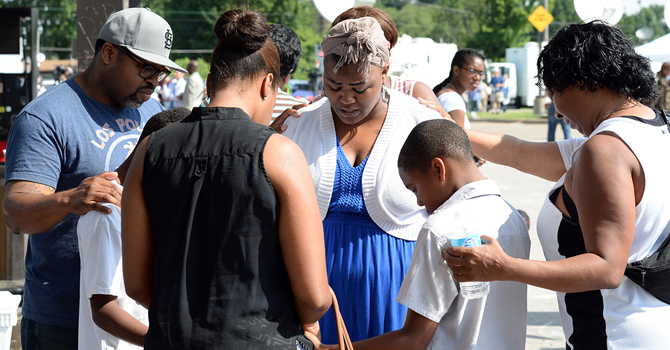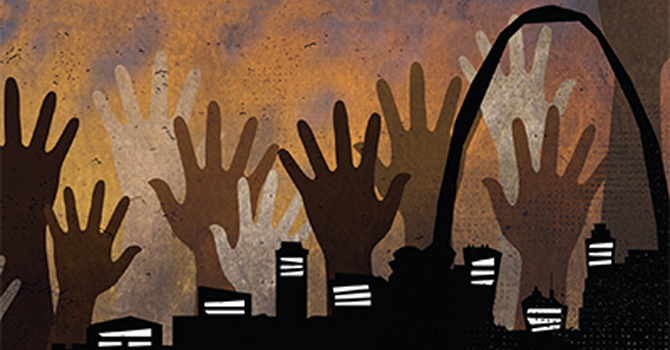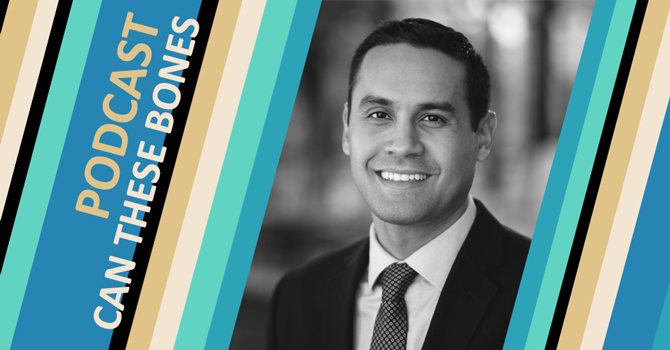On the evening of Aug. 9, 2014, I had put my boys to bed and walked into the family room when I caught a glimpse of a chaotic scene on the news. Suddenly, I heard, “You took my son away from me! Do you know how hard it was for me to get him to stay in school and graduate?”
I stood, shell-shocked, in front of the television, watching as Michael Brown’s mother spoke. Her son had been shot and killed by a police officer.
I am a mother of black sons. I live with my family in St. Louis; our home is only 11 miles from the Canfield Green Apartments, where Brown was killed.
This was too close to heart and home for comfort. The discomfort in my heart and spirit catapulted me into the streets and called out the leader within. I joined thousands of others at this intersection of faith and justice in Ferguson.
My multiple roles as a scholar-activist-mother of black sons-fellow protestor afforded me the opportunity to collect some of the stories that helped shape the movement for racial justice in Ferguson.
Those stories are gathered in my book “Ferguson and Faith,” which came about after colleagues at the Forum for Theological Exploration (FTE) and Chalice Press invited me to write about clergy involvement in Ferguson.
Read an excerpt from "Ferguson and Faith."
“Where are the leaders?” was a common question I heard coming from pundits, politicians and everyday people. After Brown’s death, thousands of people creatively protested around the St. Louis region. There were marches in Clayton, rallies in Ferguson, vigils in Chesterfield, die-ins in Brentwood and highway shutdowns in St. Louis.
For months, there were often several protests happening at once, each seeming to sprout up with little public warning. These actions often made people wonder who was in charge of this movement, and when was he or she going to speak up and get everyone under control?
The truth is that leaders were everywhere. People were inclined to look for one person, in the mode of the Rev. Dr. Martin Luther King -- but that model did not fit this movement. Leaders emerged organically from the ground up, not from the top down. They were not appointed, nor did they fit any stereotypical model of what a “leader” looks like or how a leader talks.
They were women and men; black, brown, beige and white; gay and straight; able-bodied and differently abled; well-heeled and bare-heeled; young and not-so-young. These people found themselves responding to a call that came from around them and within them, and they refused to remain on the sidelines at such a time as this.
As I talked to people on the ground, the organic emergence of leaders became more apparent to me. Every clergyperson I began speaking with would inevitably say, “But you have to interview so-and-so.”
In particular, it is important to acknowledge the role of young leaders within the movement. Indeed, the argument could be made that young people ignited leadership among clergy; they created the space and the impetus for the clergy to live into their roles as leaders.
Even though I interviewed 24 St. Louis-area faith leaders and 13 young activists, I captured just a snapshot of leadership in the movement for racial justice in Ferguson, not the entire picture.
I firmly believe that these stories of courage contain seeds of possibilities -- seeds that, if nurtured, could serve us well into a future filled with hope. I’d like to share two of the stories from people that shaped the contours of leadership.
Alisha Sonnier is a student at St. Louis University, where protestors occupied a courtyard surrounding the clock tower in the middle of campus. Sonnier is a founder of Tribe X, an organization created in the wake of the protests to raise awareness about the racial disparities and inequities on campus. The protesters began meeting with school administrators, and the resulting agreement was called the Clock Tower Accords.
“After the first night in Ferguson, we went out there so many more times. You ran into a lot of people you often saw there, a lot of familiar faces. You had a lot of similar conversations. … We were just talking about ways that we could be effective, and we were just tired of just talking about it and complaining about it, but we wanted to figure out, ‘What could we do?’ And so it was actually suggested to us by one of our advisors, ‘Well, why don’t you guys start an organization?’”
Another seed of hope emerged during my conversation with Krista Taves, a Unitarian Universalist minister in an affluent suburban congregation. She wanted to awaken her congregation to their own community’s issues of racial injustice. One step she took was to have persons of color in the congregation give testimony of personal experience of racial injustice.
“They talked about police brutality and racial profiling, about the killing of unarmed black men by white police officers, about the school-to-prison pipeline. And to the surprise of many, including me, people walked out. They walked out of the service, because they felt that it was bashing the police and that their church was taking sides. That’s how it started for us in this [largely] white, predominantly middle class congregation in far West County.”
Despite the pushback, Taves continued to preach about what was happening in Ferguson. The church’s social justice team met weekly, trying to figure out a response. The turning point came when a Cambodian teenager, adopted by a white single mother, spoke to the congregation about her experience as a person of color.
“The tears in that service were unbelievable. That’s what brought it home. The relationship they had with that family brought it home. I asked the congregation, ‘What is our response to this? Because this is here. What’s happening in Ferguson is here. … How are we going to stand together as a community?’”
These are just two stories among many. The beauty of this garden of hope is that each seed represents an expression of someone’s leadership emerging in its own vital and beautiful way -- even when the heart of protest is pain.
Leadership is not just about getting people to do what you want them to do. Instead, it involves asking how your core values and beliefs are compelling you to respond to the situation at hand, as Sonnier and Taves have done.
Whenever we respond to the call to lead from our own moral center, not self-centeredness, we create space and opportunity to join God’s work in the world.
When we dare to stand at the crossroads of faith and justice and ask where the good way is, and muster the courage to walk in the way of love, mercy and humility, we forge pathways to the kingdom of God on earth.
I had the privilege of sharing time and space with many people who responded to this call to lead us into a future filled with hope. The call is still open. What say you?











